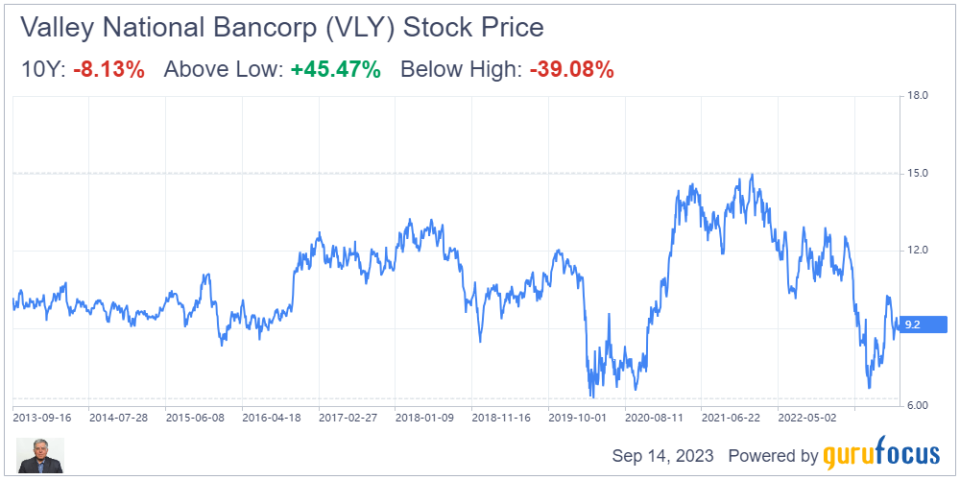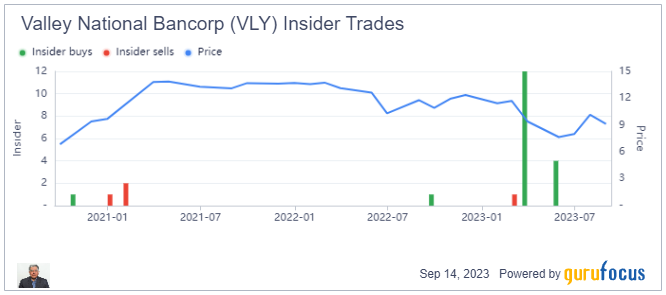Is Valley National Bancorp a Good Buy or a goodbye?
Valley National Bancorp is a bank holding company based in New York City, New York. It employs around 3,826 full-time employees. The company's main subsidiary is Valley National Bank. It provides a wide range of banking services, including consumer and commercial deposit and lending products, commercial real estate financing, small business loans, equipment financing, insurance, wealth management, cash management, and personal financing solutions like mortgages, home equity loans, and automobile financing. Additionally, the company offers specialized financial services such as loans and deposits for homeowners' associations, insurance premium financing, and banking services for cannabis-related businesses.
During the banking crisis in March earlier this year, which resulted in the failure of two banks Silicon Valley Bank and Signature bank, Valley like many other banks got hit. The stock has recovered somewhat but is still 39% below its high from last year.
Valley has experienced substantial insider trading over the last few months. Most of the insider buys have occurred at a higher price than the stock is trading currently at, and there has been no insider selling. This is invariably a good sign because insiders sell shares for many reasons, including tax purposes, estate planning, diversification, funding a large purchase or perhaps a charitable donation. On the other hand, they buy (like most of us) for one main reasonthey think the stock is going higher. It therefore makes sense to pay particular attention when you see insider buying in a stock you are interested in.
I look a several important metrics to assess banks. These are as follows:
Ticker | Company | Current Price | Tangible Book per Share | Price-to-Ta ngible-Book | PB Ratio | ROE % | ROA % | Price-to-Gr aham-Number | 10-Year Book Growth Rate (Per Share) | PE Ratio (TTM) | Market Cap ($M) |
Valley National Bancorp | 9.14 | 8.51 | 1.07 | 0.73 | 10.03 | 1.09 | 0.60 | 5.10 | 7.43 | 4,642.32 |
Some of them are discussed below.
1. Book Value: Valley's price to book value ratio is 0.73. Price to Tangible Book Value ratio is 1.07. Both these ratio's look excellent.Book value is highly significant for banks due to its multifaceted role in assessing their financial health, risk resilience, and overall stability. It serves as a fundamental indicator, representing the value of a bank's assets minus liabilities, which aids in evaluating a bank's net worth. This metric is crucial for regulatory compliance, ensuring that banks meet capital requirements and withstand economic downturns. Investors use it to assess stock value, while it also plays a pivotal role in mergers and acquisitions, helping determine fair acquisition prices. Book value influences creditworthiness, impacts lending decisions, and is integral in stress testing exercises to gauge a bank's resilience in adverse scenarios. In essence, book value is a foundational factor guiding financial and strategic decisions for banks and their stakeholders.Tangible book value per share is important because it shows the value of a company's net assets minus its intangible assets on a per share basis. Intangible assets are important, but they're not physical assets that can be readily sold if the company gets into trouble. Its an even more conservative measure than book value.
2. Return on Equity: Valley's Return on Equity 10.03% which is quite good especially considering that the P/B is below 1.Return on equity (ROE) holds significant importance for banks as it serves multiple critical functions. First and foremost, it acts as a key profitability gauge, revealing how effectively a bank generates earnings relative to shareholders' equity. It also functions as an efficiency indicator, highlighting the bank's ability to deploy capital efficiently. ROE plays a pivotal role in attracting investors and building their confidence in the bank's performance. Simultaneously, it aids in assessing the bank's risk profile, with a high ROE potentially indicating increased risk. Regulators utilize ROE to evaluate financial stability and adherence to capital requirements, and banks use it for benchmarking against peers, guiding capital allocation decisions, and informing strategic planning. In essence, ROE encapsulates a bank's profitability, efficiency, and risk, making it a crucial metric for performance evaluation and decision-making in the banking sector.
3. Price to Graham Number is 0.60 which is good. Valley's Graham Number is 15.34.
Graham Number is a conservative valuation approach that measures a stock's fundamental value by taking into account the company's earnings per share and tangible book value per share. (Graham Number = Square Root of (22.5) x (TTM EPS) x (Book Value per Share)). The 22.5 is included in the formula as a rule of thumb to account for Graham's assumption that the price-to-earnings ratio should not be over 15 and the price to book ratio should not be over 1.5 for an undervalued stock. The Graham number is the upper bound of the price range that a defensive investor should pay for the stock. According to this theory, any stock price below the Graham number is considered undervalued, and thus worth investing in. Currently there is a 40% margin of safety even below the Graham number.
Summary
For the reasons explained above Valley National Bancorp checks out as a worthy investment. Valley pays a dividend yield of 4.8% with a payout ratio of 0.35. Its PE ratio is 7.43 which tells me that the market is not expecting any growth from the stock. In spite of that Valley has succeeded in growing its book value by over 5% annually over the last 10 years. Therefore if the economy remains healthy, Valley has the potential to deliver a surprising upside. Therefore the answer to opening question is: Yes, Valley National Bancorp is a Good BUY.
This article first appeared on GuruFocus.


